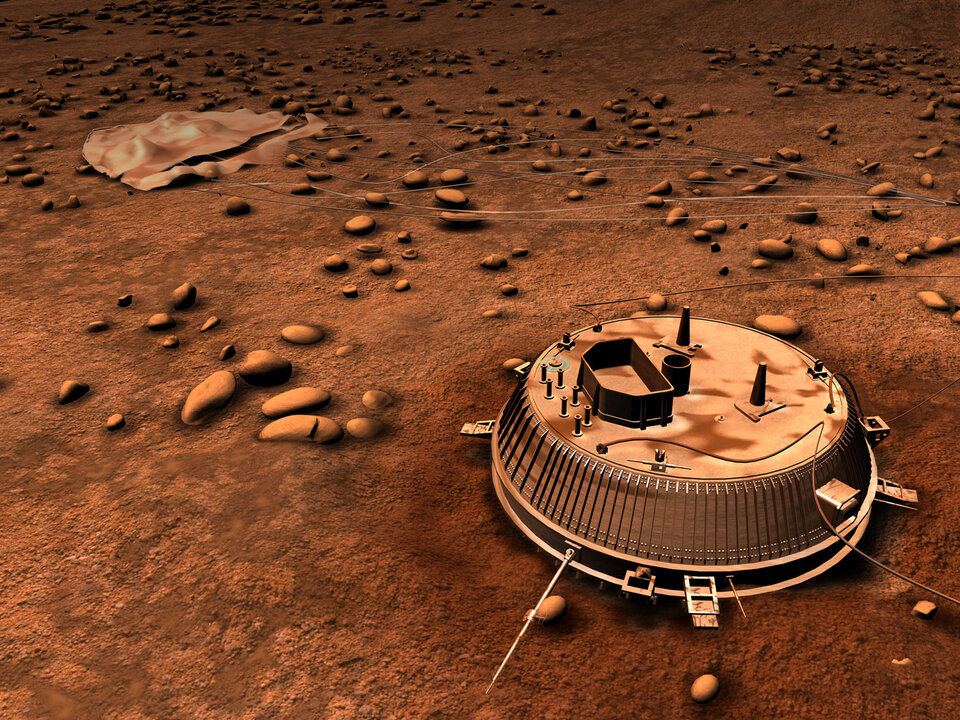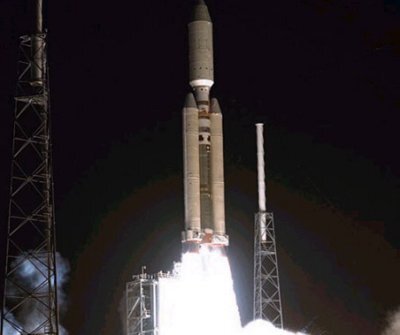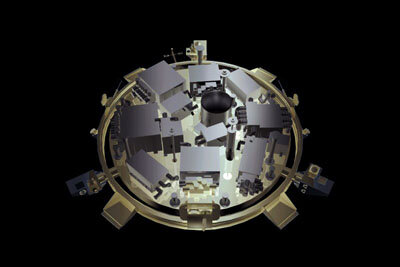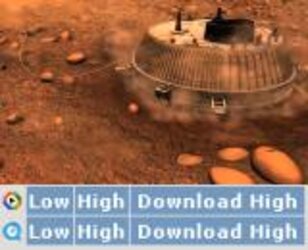Cassini-Huygens
| ROLE | Study Saturnian system; descend to Titan |
| LAUNCH DATE | 15 Oct 1997 |
| LAUNCHER/LOCATION | Titan IVB-Centaur/Cape Canaveral, Florida |
| LAUNCH MASS |
5600 kg (combined) 318 kg (Huygens probe) |
|
NOMINAL MISSION |
Cassini: 4 years - extended to mid-2010 Huygens: COMPLETE |
| + Cassini-Huygens is one of the most ambitious exploration missions of all time while Huygens' touch-down on Titan is the farthest landing from Earth ever made + | |
The mission

The Cassini-Huygens mission to Saturn is noted as being one of the most ambitious planetary exploration missions ever mounted. A joint endeavour of ESA, NASA and ASI, the Italian space agency, Cassini-Huygens arrived at Saturn on 1 July 2004 and explored the ringed Saturnian system in detail over an initial four-year period.
ESA's Huygens probe was released from Cassini on 25 December 2004. Huygens continued on to Titan, Saturn's largest and most interesting moon, descending via parachute and touching-down at 11:30 UTC, 14 January 2005. The descent phase lasted around 2 hours, 27 minutes, with a further 1 hour and 10 minutes of operation on the surface.
The Huygens Probe Operations Centre (HPOC) was located at ESOC, Darmstadt, Germany. The Cassini Space Flight Operations Facility is located at NASA's Jet Propulsion Lab (JPL), California.
The Flight Control Team

The Huygens Flight Control Team (FCT) comprised the Spacecraft Operations Manager (SOM), Claudio Sollazzo, and a 7-person team of engineers and spacecraft controllers working at ESOC and at NASA/JPL.
Sollazzo was associated with the mission in several capacities over a span of 14 years.
The FCT is supported by numerous ESOC specialists in the areas of flight dynamics, software support and ground stations, among others. The team also worked closely with NASA controllers.
Mission operations overview

The Cassini-Huygens spacecraft was launched at 08:43 UTC, 15 October 1997, by a Titan IVB-Centaur rocket from Cape Canaveral Air Force Station in Florida, USA. The 5.6-tonne spacecraft was too heavy to be injected into a direct trajectory to Saturn, so the interplanetary voyage of about 6.7 years included gravity-assist manoeuvres at Venus, Earth and Jupiter.
Cruise Phase
During the first two years, the Cassini-Huygens spacecraft performed three gravity-assisted manoeuvres, flying by Venus twice and once by the Earth. During the entire cruise phase, spacecraft activities were mainly related to routine maintenance of the orbiter's engineering subsystems and scientific payload.
Huygens underwent regular checkouts to monitor the health and status of the probe and its components. Following the detection of the Cassini transponder anomaly during one of the regular probe relay tests, a redesign of the Huygens mission was performed. The required changes to the software of Huygens and its experiments were uploaded, tested and verified during later checkout campaigns together with other activities such as on-board software maintenance and payload-specific tests.
Telecommunications with the probe were routed via the Cassini Mission Support Area (MSA) at NASA/JPL and used NASA's Deep Space Network (DSN) antennas.
Saturn Orbit Insertion
Upon arrival at Saturn, 1 July 2004, the spacecraft executed the Saturn Orbit Insertion manoeuvre (SOI), which lasted 96 minutes and brought Cassini to within 20 000 km of the cloud tops of Saturn; the initial orbital period around Saturn was less than 4 months.
On 23 August 2004, the spacecraft executed a manoeuvre to raise its orbit periapsis and to target the combined orbiter-and-probe for the first of a series of three close Titan flybys. The first of these flybys will toke place on 26 October with closet approach of only 1200 km, the closest Titan flyby ever flown. Titan's gravity exerted a braking effect on the spacecraft, reducing its orbital period to 48 days and retargeting for the next flyby on 13 December.
The second Titan flyby, at an altitude of 2500 km, further reduced the orbital period to 32 days in preparation for the third Titan encounter on 14 January 2005, the planned Huygens descent date. During the first two Titan flybys, valuable information concerning the final planning of the probe mission was obtained.
Orbiter-Probe Separation
The Huygens probe was released on 25 December 2004; Cassini then performed a deflection manoeuvre to place itself onto a trajectory that passed a safe distance over Titan with a delay of several hours with respect to the probe's planned arrival. The orbiter trajectory was carefully designed so that the orbiter could collect data transmitted from Huygens during descent.
After the probe's release, it was no longer be possible to send commands to Huygens from the ground. All probe activities will from then on were controlled by on-board autonomous event- and timer-driven sequences. During the coast phase, the probe was dormant, with only a timer running. Shortly before the probe was predicted to enter the atmosphere of Titan (about 3 hours prior to surface touch-down), the timer initiated a sequence of events, including the initial turn-on of power to its subsystems and scientific instruments.
Probe Entry & Descent
On 14 January 2005 the Huygens probe successfully entered Titan's upper atmosphere and descended under parachute to the surface. The descent phase lasted around 2 hours, 27 minutes, with a further 1 hour, 10 minutes of operation on the surface. During the entry phase, the probe cannot transmit telemetry, so a limited set of engineering housekeeping data is stored on board for later transmission to the orbiter.
Later, during descent, data was collected from all instruments providing a detailed scientific picture of Titan's atmosphere and surface.
The probe's descent was controlled by parachutes. The aerodynamic conditions under which the main parachute deployed were critical; the correct instant was determined by accelerometers that monitored the deceleration. Pyrotechnic devices released the front shield and back cover, and a pilot parachute pulled out the main parachute.
Subsequent events were determined by a software timer, initiated at the moment of parachute release, T0. These events included:
- Establish a radio relay link for transmission of data back to the orbiter for recording and later playback to Earth
- Switching on instruments
- Deployment of a smaller drogue parachute to ensure that the probe reaches Titan's surface within the design duration of the mission (150 minutes maximum for the descent, and at least 3 minutes on ground)
That duration is constrained by the capacity of the probe batteries and by the changing geometry of the relay link as the orbiter continues on its orbit about Saturn.
During the descent phase, the probe transmitted S-band signals (2040 & 2090 megahertz on two redundant communication channels, or chains). Data relayed from the probe was collected and stored redundantly by the orbiter in two solid-state recorders. The recorded probe data was subsequently transmitted to Earth and sent to the Huygens Probe Operations Centre (HPOC) at ESA/ESOC.
Landing
After a spectacular descent, Huygens landed on Titan at 11:30 UTC, 14 January 2005. The probe continued to gather data from the surface for an additional 1 hour, 10 minutes. After this time, Cassini had orbited past the landing site and out of line-of-sight radio contact, so no more data could be received. Afterwards, the probe's battery power ran out, and the probe ceased operation, as it was designed to do.
The ground stations
NASA DSN

For Cassini, telecommunications and data receipt is provided by NASA's Deep Space Network (DSN). The network consists of three deep space communications complexes located approximately 120 degrees of longitude apart around the world: at Goldstone, California; near Madrid, Spain; and near Canberra, Australia. This placement permits continuous communication with deep space spacecraft.
During the cruise phase, communications between mission controllers at ESOC and Huygens was provided via the Probe Support Equipment (PSE) mounted on board Cassini. During descent, data was transmitted from Huygens to Cassini via radio link. No telecommands were sent to Huygens once it separated from Cassini and all operations thereafter were automatically executed from preprogrammed instructions.
Ground segment & mission control system
There was no traditional mission control system established at ESOC; all commands to Huygens were relayed to Cassini via NASA/JPL. The Huygens operations team at ESOC worked extensively with the Huygens engineering model and simulation software and hardware for testing and validation during the cruise.
The platform and payload

The probe comprised the Entry Assembly (ENA), which cocoons the Descent Module (DM). The ENA provides Orbiter attachment, umbilical separation and ejection, cruise and entry thermal protection, and entry deceleration control. It was jettisoned after entry, releasing the Descent Module.
The DM comprises an aluminium shell and inner structure containing all the experiments and probe support subsystems, including the parachute descent and spin control devices.
The PSE (Probe Support Equipment) on board Cassini consists of:
- Four electronic boxes - two Probe Support Avionics (PSA) units, a Receiver Front End (RFE) and a Receiver Ultra Stable Oscillator (RUSO)
- The Spin Eject Device (SED)
- The harness (including the umbilical connector) providing power, radio and data links between the PSA, the probe and the orbiter
The Payload
Huygens is a sophisticated robotic laboratory equipped with six scientific instruments, which in turn include a number of sensors and detectors.
|
Instrument |
Name |
| ACP | Aerosol Collector and Pyrolyser |
| DISR | Descent Imager and Spectral Radiometer |
| DWE | Doppler Wind Experiment |
| GCMS | Gas Chromatograph and Mass Spectrometer |
| HASI | Huygens Atmospheric Structure Instrument |
| SSP | Surface Science Package |





